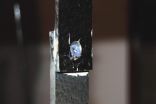Tool developed to predict violence and aggression in children and teens
Researchers hope to combine questionnaire with 'biomarkers of aggression' to better predict pediatric aggression and violence
2011-06-14
(Press-News.org) Researchers at Cincinnati Children's Hospital Medical Center have developed a tool to rapidly assess the risk of aggressive and violent behavior by children and adolescents hospitalized on psychiatric units. Ultimately, they hope to use the questionnaire to improve treatment and prevention of aggressive behavior in schools and in the community.
A study providing preliminary validation of the Brief Rating of the Child and Adolescent Aggression (BRACHA) tool is published online in the Journal of the American Academy of Psychiatry and the Law.
"Using the BRACHA could help hospitals cut down on violence," says Drew Barzman, MD, a child and adolescent forensic psychiatrist at Cincinnati Children's and lead author of the study.
The study involved 418 children and teens who had been hospitalized on psychiatric units at Cincinnati Children's. Prior to hospitalization, they were evaluated in the emergency department by psychiatric social workers who administered the BRACHA questionnaire. A total of 292 aggressive acts were committed by 120 of the hospitalized patients (or 29 percent). Fourteen of the 16 items on the survey were significantly associated with aggression by children and teens.
The researchers expect to further validate the updated 14-item BRACHA questionnaire in a larger study of about 1,000 to 1,500 patients in their database.
"The BRACHA may ultimately help doctors improve safety in hospitals, reduce the use of seclusion and restraint in the inpatient setting and focus interventions on reducing aggression-related risk," says Dr. Barzman. "The long-term goal is to prevent kids from going down a criminal path. If we can find high risk children before they become involved with the juvenile justice system, which is why we are studying 7 to 9 year olds, we can hopefully provide more effective treatment and prevention."
The BRACHA study was funded by grants from the National Institutes of Health and Cincinnati Children's.
Combining Questionnaire with New Research
Dr. Barzman and fellow researchers also are now examining two dozen 7- to 9-year-old psychiatric inpatients to determine whether levels of three hormones in their saliva (biomarkers of pediatric aggression) – testosterone, cortisol and DHEAS – can be combined with the BRACHA questionnaire to even better predict aggressive behavior in the hospital and also improve treatment and prevention outside hospital walls.
"In previously published studies, investigators linked levels of these hormones with levels and types of aggression and violence," says Dr. Barzman. "We're hoping our current salivary study, in conjunction with the BRACHA questionnaire findings, will provide even more meaningful results."
###
The salivary hormone study is being funded by the American Academy of Psychiatry and the Law.
END
ELSE PRESS RELEASES FROM THIS DATE:
2011-06-14
Approximately 12 million people in the United States are cancer survivors. On average, their medical care costs $4,000 to $5,000 more annually than the care of people who have never had cancer, according to Penn State researchers.
Those who are treated for and survive cancer are susceptible to later health complications and their total medical expenses average about $9,300 per year. People are considered cancer survivors from the moment they are diagnosed through the end of their lives. Advances in medicine enable more people to survive cancer, but there is little information ...
2011-06-14
The idea for this research arose when the problems of the large structural components of an airplane were being analyzed. These components are made up of a large number of different elements, which are themselves assembled using a variety of techniques, such as soldering, mechanical or adhesive bonding or a combination of these. Of these techniques, mechanical bonding is the method most commonly used in components made of composite materials. For example, the wing of an Airbus 380 alone is composed of over 30,000 elements, with approximately 750,000 bolted joints. These ...
2011-06-14
NEW YORK, NY – June 13, 2011 – Data from the landmark HORIZONS-AMI clinical trial demonstrated that the administration of the anticoagulant medication bivalirudin enhanced survival compared to the use of heparin plus a glycoprotein (GP) IIb/IIIa inhibitor in heart attack patients undergoing angioplasty after 3 years. Use of a drug-eluting stent (paclitaxel) was also shown to be more effective than a bare-metal stent, with equivalent safety. Final 3-year results of the trial were published in the June 13, 2011, issue of The Lancet.
After 3 years, treatment with bivalirudin ...
2011-06-14
This release is available in French.
Montreal, June 13, 2011 – Exposure to secondhand smoke can create symptoms of nicotine dependence in non-smoking preteens, according to a new study from Concordia University and the University of Montreal.
Published in the Oxford journal Nicotine & Tobacco Research, the study also found that tweens who repeatedly observe a parent, sibling, friend or neighbor consuming cigarettes are more likely to light up themselves as adolescents.
"Kids who see others smoking are more likely to take up the habit because they don't perceive ...
2011-06-14
Migraine is a neurovascular disease that affects about 15% of the western population. Compounds in foods and beverages (chocolate, wine, citrus, etc) considered as migraine triggers include tyramine, phenylethylamine and possibly histamine and phenolic compounds. Avoiding those triggers may significantly reduce the frequency of migraines in some patients.
However, only a small percentage of patients in one study became headache-free simply by excluding those foods, epidemiological studies are pointing out that genetic factors may be an underlying cause. Discrepancies ...
2011-06-14
Contact: Dr. Abigail Stevenson
Abigail.Stevenson@effem.com
44-166-441-5409
Waltham Centre for Pet Nutrition
Waltham Centre for Pet Nutrition advances understanding of factors influencing body weight in cats
New research by the Waltham Centre for Pet Nutrition marks an important step forward in the fight against cat obesity
13th June, 2011 – A collaborative team of researchers has shown that adding moisture to a cat's diet slows down the rate of weight gain. This finding, at least in part, appeared to be driven by increased activity. This research was conducted at ...
2011-06-14
Boston, Mass – Guidelines that reduce the use of mechanical ventilation with premature infants in favor of a gentler form of respiratory support can profoundly affect those children's outcomes while reducing the cost of care, according to a team of researchers at Children's Hospital Boston.
The team, led by Bernadette Levesque, MD, of the Division of Newborn Medicine at Children's Hospital Boston and the Neonatal Intensive Care Unit (NICU) at St. Elizabeth's Medical Center in Boston, published their findings today online in Pediatrics. Children's operates the NICU at ...
2011-06-14
CAMBRIDGE, Mass. -- Photographs of moving objects are almost always a little blurry. To make their work look as much like conventional film as possible, game and movie animators try to reproduce this blur. But producing blurry images is actually more computationally complex than producing perfectly sharp ones.
In August, at this year's Siggraph conference — the premier computer-graphics conference — researchers from the Computer Graphics Group at MIT's Computer Science and Artificial Intelligence Laboratory will present a pair of papers that describe new techniques for ...
2011-06-14
Hippocampus adapts to environmental stresses
Stockpiles neuronal stem cells under deprived conditions, produces more neurons under favorable conditions
Knowledge of how neural stem cells produce neurons could lead to potential treatment for neurodegenerative diseases such as Alzheimer's and Parkinson's
(NEW YORK, NY, June 13, 2011) – Scientists have known for years that neurogenesis takes place throughout adulthood in the hippocampus of the mammalian brain. Now Columbia researchers have found that under stressful conditions, neural stem cells in the adult hippocampus ...
2011-06-14
COLUMBIA, Mo. – The United States federal government supports many welfare and entitlement programs that attempt to eliminate poverty by providing financial assistance to families in need. Now, a researcher at the University of Missouri has found that requirements for some of these welfare programs can create stress on families, which can have a negative effect on young children.
Colleen Heflin, an associate professor in the Truman School of Public Affairs at the University of Missouri, studied the cognitive scores of young children whose families receive assistance from ...
LAST 30 PRESS RELEASES:
[Press-News.org] Tool developed to predict violence and aggression in children and teens
Researchers hope to combine questionnaire with 'biomarkers of aggression' to better predict pediatric aggression and violence

